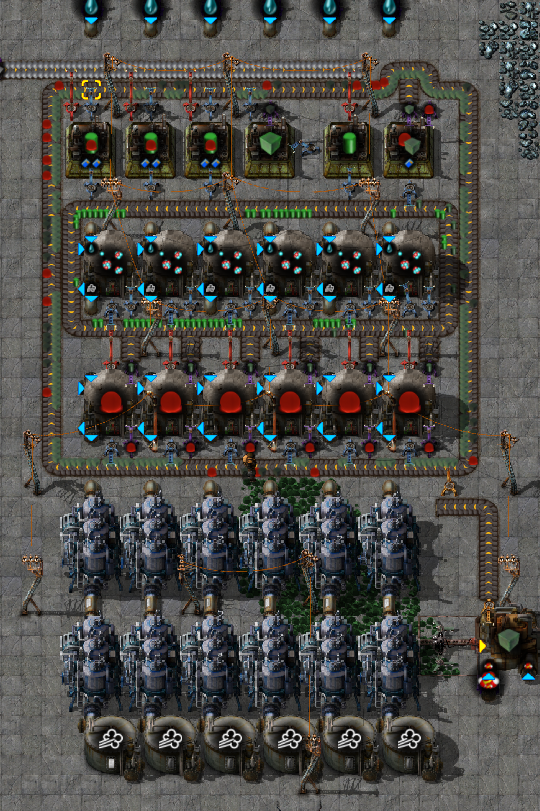BlakeMW wrote:I remember another reason why I always like to be over-ratio on steam engines/turbines. If you are exactly on-ratio then assuming the reactors are working properly the steam level will never deplete (much) even at full load. If you're at over-ratio, then when the system is under greater than full load, the steam level depletes. This is a really neat feature, because you can link a steam storage tank to the circuit network, and use the steam level as a cue to activate offshore pumps to bring up backup steam. Admittedly you can do much the same with an accumulator, although the storage tank method allows direct monitoring of the nuclear setup (I also often output the signal into a row of lights in the center of my factory to give a visual cue if the nuclear setup needs upgrading).
i'm having trouble understanding the benefit of being "over-ratio on steam engines". my understanding is that one fission reactor can support just under 2 steam turbines but that it's close enough that, for practical purposes, we can use a 1:2 ratio as long as we're mindful of how close we are to full load.
i very much like the the circuit triggered activation of pumps to both bring in back-up steam and notify us in some way or another. but what i don't understand is what we gain by having steam engines in excess of 2:1 (given we all agree that 100% load is not sustainable for 2:1, even if only just barely). what am i missing?
Also, a question regarding monitoring of our nuclear plant - i forced a few situations such as the spent-nuclear-fuel belt getting backed (which results in an eventual shutdown of the plant) so I could see exactly how the shutdown commences since we'll want to know at the first instance of steam levels dipping meaningfully below maximum. I saw that this dip doesn't necessarily happen at the very last pair of steam turbines in the layout - it could be somewhere in the middle. So am I correct in saying that a proper monitoring will involve a storage tank for each set of steam turbines with a system designed to alert if any of these of storage tanks dips below say 75% (or some other threshold)?
***
Also, if anyone wants to play around with the figures, here is a spreadsheet (
https://docs.google.com/spreadsheets/d/ ... sp=sharing) that I made to better understand the dynamics of the Nucular mod's power production cycle. Blue numbers are hard-coded values, black numbers are formulas. We can input the target MW in the yellow shaded cell at the top and it will calculate the required number of various facilities to ensure (1) a net balance (i.e., net rate of 0, in the gray shaded cells) of uranium, enriched uranium, depleted uranium and spent nuclear fuel and (2) a positive balance (i.e., surplus) of nuclear fuel. We can also see (3) the negative balance (i.e., the cost) of uranium ore, iron and sulfuric acid.
The relevant table is the bottom-most one (i.e., third from top): going across the columns, we see each item/intermediate in the Nucular mod's power production cycle. Going down the rows, we see each process / facility in the power production cycle. The table simply populates the rate of production / (consumption) of a particular item in a particular process (parentheses denote negative rates, i.e., corresponding to consumption of an item/intermediate). The purpose of this arrangement of figures is so that we can quickly determine the net production/(consumption) rate at an assumed facility count (which is shaded blue) by simply summing down that item's column.
Two notable observations:
[*] Uranium "injections" (into the MOXX fuel assemblers) are not necessary when a system is at full load. We can see in the Uranium column that the uranium production rate of the chemical plant (that's processing uranium ore) is identical to the uranium consumption rate of the assembler that's making enriched + depleted uranium. At the same time, the uranium production rate of the reprocessing assemblers is exactly offset by the consumption rate of the moxx fuel assemblers.
[*] A surplus of nuclear fuel is created at full load, even when all other non-consumable items (i.e., everything but iron, sulfuric acid and uranium ore) amounts staying constant.
In practice, we'll of course still need a set of checks & balances for controlling uranium input to the moxx fuel plants as this perfect equilibrium exists only at full load. I've used the model to scale up to 5gw with no hiccups over many hours. The one difference in implementation from what has already been described is due to the fact that I rely on the depleted uranium as my primary source of ammunition (i play with natural evolution mods). (Although depleted uranium production is zero at full load, it is net positive when we're operating below capacity.) So instead of suppressing uranium output from the chemical plant, my alternative method is simply to direct excess uranium into the enrichment process (which gives me my depleted uranium) and to then send the enriched uranium from this step over to another assembler which converts it into a nuclear warhead (which, when combined with bad aim, ended up getting me the golem achievement for my modded achievement set

).
Atm, I'm assuming 5.4mw per steam turbine. It's prepopulated with 810MW because it works out to a nice set of numbers (75 fission, 75 breeder, 48 moxx fuel, 16 reprocessing, etc.).
